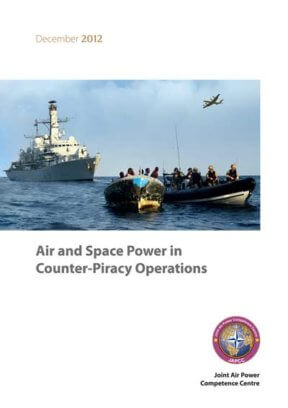Background
NATO has been contributing military forces, mostly warships, to the Counter-Piracy (CP) mission off the Horn of Africa (HoA) since October 2008. Commanders at sea have made several strong appeals for more Air and Space (A&S) assets, namely, Maritime Patrol Aircraft (MPA), Airborne Warning and Command System (AWACS) and UAS Systems stating that A&S assets are required to ensure rapid reaction capabilities and to enhance situational awareness. A limited number of assets have been operating under the European Union (EU) Flag (Operation ATALANTA), and the US-led Combined Maritime Force (CMF). Other than organic helicopters aboard warships, NATO only recently contributed air assets to its own mission, Operation Ocean Shield (OOS), but in limited numbers and with intermittent deployments.
This low weight of effort is likely to persist. However, if the effects of piracy were to become more severe in terms of economics and safety for seafarers, the priority of the CP mission would likely rise and the Alliance may resolve to deploy A&S assets. As such, NATO nations must be prepared to deploy and employ the most effective and efficient mixture of A&S forces.
Aim
The aim is to provide an insight into the A&S Power contribution to CP operations off the HoA by determining the optimum use of A&S assets in the CP mission.
Specifically, as a preparedness prerequisite for the deployment and employment of NATO A&S assets for CP, this document attempts to fill the need to define the best composition of capabilities for the most efficient and effective Intelligence, Surveillance and Reconnaissance (ISR) support to maritime forces.
As a secondary objective, this document also seeks to extract best-practice concepts for the enhancement of regional Maritime Domain Awareness.
To achieve the aims, the JAPCC addressed the CP issue via a scientific and empirical approach based on an experiment executed by the Boeing Portal, a Boeing Defence UK Ltd asset specialised in advanced modelling, simulation and analysis.
Purpose
Naval operations have increasingly gained relevance in the law enforcement actions against piracy. This paper considers the positive influence that A&S Power can produce in the overall effort to disrupt piracy. It also sets the objective by providing the necessary background information to prepare the Alliance with a detailed plan for ISR A&S support to CP off the HoA, which could also be set as a model for the enhancement of NATO’s understanding of how to most effectively and efficiently employ A&S assets in support of other Maritime Security Operations (MSO).
Application
In general, this document is designed to be a readily-accessible reference for use by those personnel with responsibility for or interest in the application of A&S Power in CP operations.
Being based on the results of an experiment, this document is not intended to provide authoritative or definitive advice, nor is it a substitute for relevant doctrine, policy or reference documents.
Primary stakeholders for this paper are those headquarters running or participating and leading CP operations and those nations providing or able to provide A&S assets.
Dissemination will be assured to all NATO / EU / national headquarters and agencies engaged in the mission against piracy.
Assumptions and Limitations
- Piracy will not be entirely eliminated in the short term, even by kinetic action ashore;
- NATO will not terminate Operation Ocean Shield in the short term;
- The study is limited in scope to the A&S support to CP operations under the current limitations of OOS, meaning operations at sea and excluding engagement operations ashore from the air;
- This paper does not include a comprehensive approach on the Piracy issue, but is rather a part of it;
- To avoid duplications of existing documents and redundancy, all information on piracy and CP operations in this paper are to be considered the framework of the analysis of A&S Power contribution to CP;
- The research and the experimentation do not address the full range of A&S Power capabilities in support of CP operations, rather it mainly refers to air and space based ISR capabilities.
Authority
This paper is the result of JAPCC Subject Matter Experts (SMEs) study and research led by JAPCC Combat Air Branch. It also includes information contained in an experiment report produced by The Boeing Portal. The experiment was designed by JAPCC and the Boeing Portal under cooperation guidelines.
Classification
This document has been compiled by retrieving open source information. It therefore carries no security classification and is releasable to the public.
Reference to classified sources may be required to support more detailed analysis and formulate recommendations that go beyond the information and the findings presented here.
Acknowledgements
The JAPCC gratefully acknowledges all those individuals responding to requests for support and data provision in producing this document. Special appreciation goes to The Boeing Portal1 team for the enthusiasm, candour and expertise shown in the experimentation process, which proved to be vital for the accomplishment of the aim of this paper.











